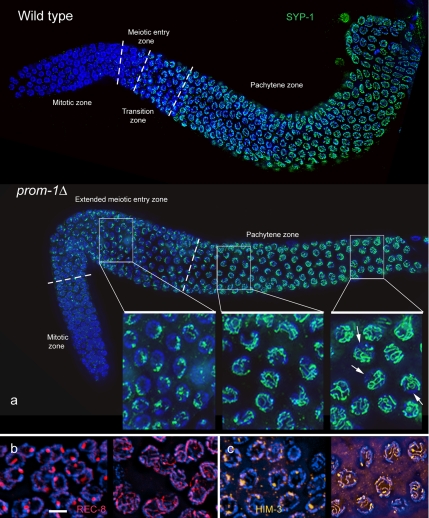Figure 3.
(a) Immunostaining of SC component SYP-1 (green) in the wild type and in the prom-1Δ mutant. In the images of whole ovaries, the broken lines mark the borders between the zones with distinguishable nuclear morphologies (see Figure 2a), namely, the mitotic zone, the meiotic entry zone and the pachytene zone. In the wild type, small spots of SYP-1 first occur in a narrow meiotic entry zone just upstream of the transition zone, and then they develop into continuous lines along the pachytene zone. In the prom-1Δ mutant, the meiotic entry zone with SYP-1 spots is greatly expanded; SYP-1 starts to form lines in the distal pachytene zone. Insets are enlarged details of the regions indicated. By the end of the pachytene zone, SC formation in some nuclei is quite extensive, as is evident from the formation of long SYP-1 lines, but incomplete (arrows denote DAPI-positive chromatin regions devoid of SYP-1). (For blow up images of corresponding regions of the wild-type gonad, see Supplemental Figure S4.) (b) REC-8 in the extended meiotic entry zone (left) and the pachytene zone (right) of the prom-1Δ mutant showing increasing formation of linear structures. (c) HIM-3 in the extended meiotic entry zone (left) where it only forms spots, and the pachytene zone (right) where in some nuclei thick HIM-3 lines suggest the presence of synapsed regions in the prom-1Δ mutant. Bar, 5 μm (b, c, and insets in a are shown at the same magnification).

